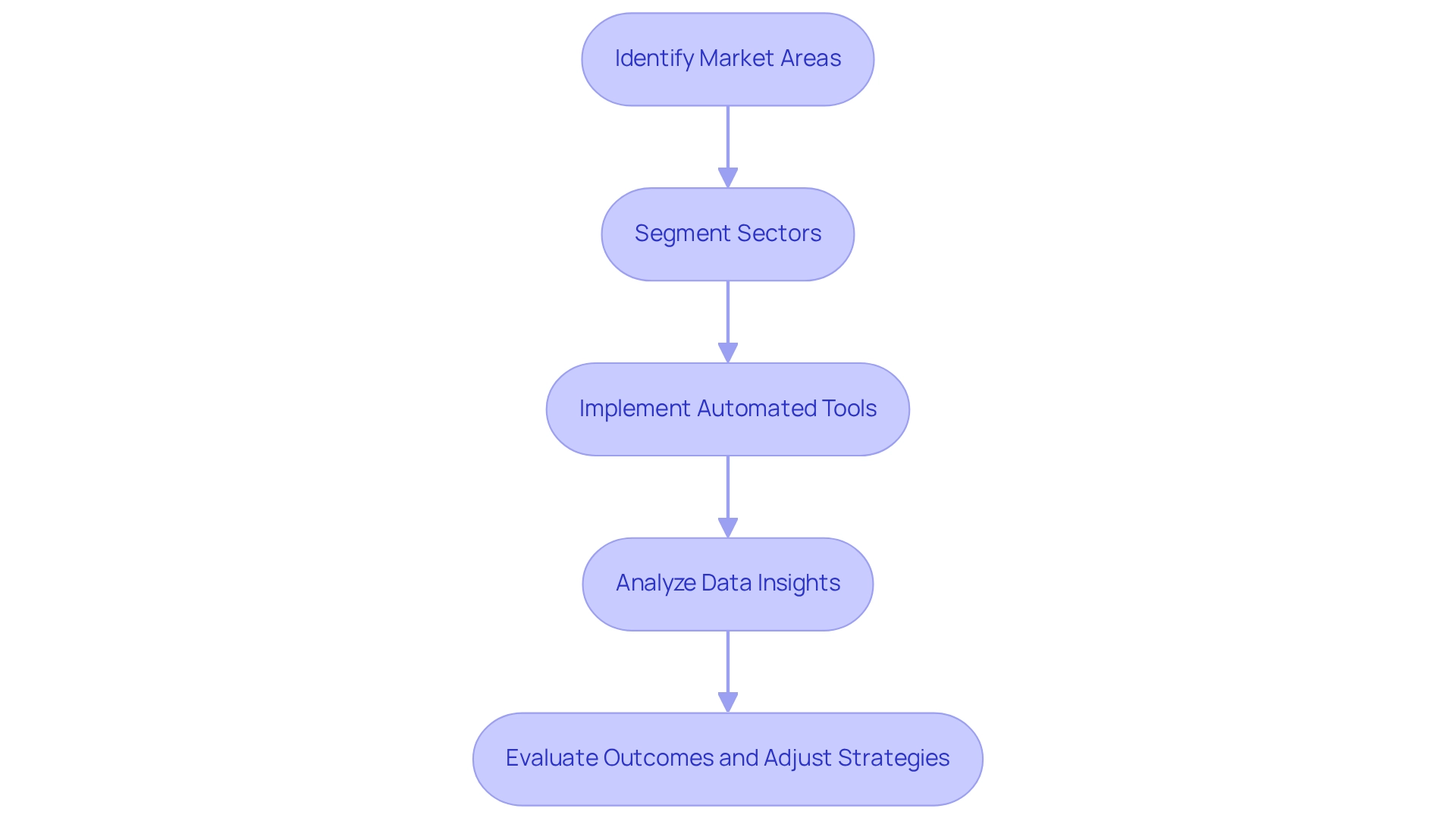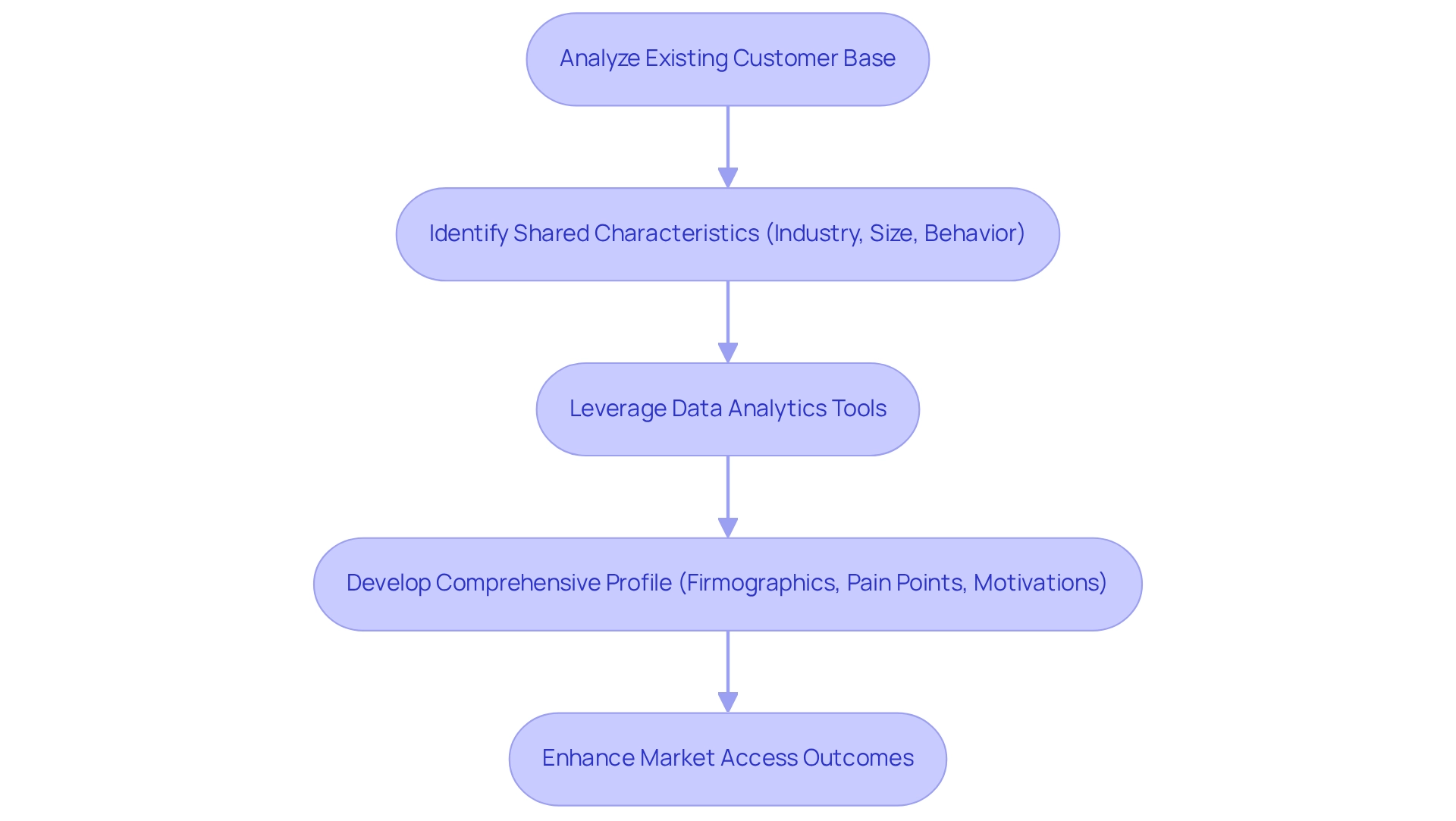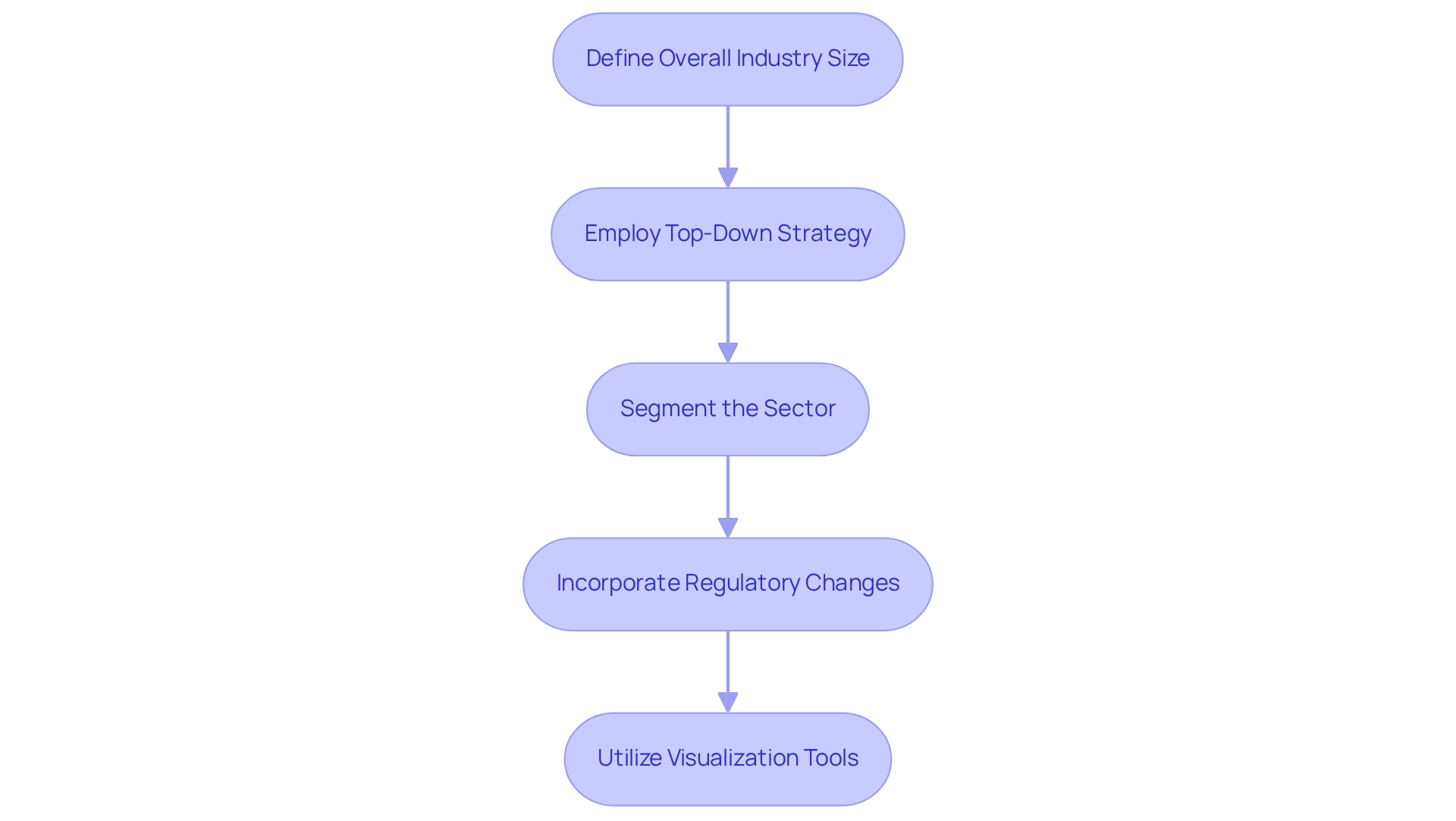Overview
Effective sales territory design is essential for enhancing market access and driving revenue growth. By strategically segmenting regions and concentrating sales efforts, organizations can significantly improve their performance. This article underscores the advantages of utilizing automated tools and data-driven insights, which foster greater efficiency, improved customer engagement, and substantial boosts in sales productivity. As organizations seek to optimize their sales strategies, leveraging these insights becomes increasingly vital.
Introduction
In the competitive landscape of sales, the strategic design of sales territories stands as a pivotal factor that can significantly influence a company’s success. By segmenting markets into manageable areas, organizations enhance their sales efforts, foster stronger customer relationships, and optimize resource allocation.
However, the journey does not end with territory design; identifying the ideal customer profile and mapping the total addressable market are equally essential steps that inform sales strategies.
Leveraging advanced analytics and comprehensive data insights, companies can create weighted sales indices to prioritize territories effectively. As organizations navigate these complex processes, implementing best practices in territory management becomes crucial for driving growth and achieving sales objectives in an ever-evolving market.
Understand the Importance of Sales Territory Design
The design of sales territories is a critical strategic procedure that segments sectors into manageable zones, thereby enhancing sales initiatives and increasing access to the market. By implementing effective sales territory design, organizations empower their representatives to concentrate on specific regions, fostering stronger customer relationships and driving overall revenue growth. This approach not only aligns marketing strategies with market demands but also significantly improves resource allocation and operational efficiency.
The benefits of effective sales territory design are substantial. Businesses that invest in automated tools for area management report impressive returns on investment, characterized by quicker cycle times and fewer design errors. For instance, organizations utilizing automated tools have experienced a reduction in the time required to finalize area designs by as much as 30% when employing four or fewer inputs, compared to those using five or more inputs. This remarkable decrease underscores the efficiency gained through automation, which streamlines the area management process and enhances the accuracy of area designs.
Incorporating CareSet’s extensive Medicare data insights can further refine sales territory design. By leveraging insights from over 62 million beneficiaries and 6 million providers, organizations can make informed decisions that align with market requirements. Expert insights underscore the importance of data-driven sales territory design. As articulated by the Sales Management Association, “Data insights enable leaders to identify areas for enhancing area design, balance, and travel efficiency.” This highlights how effective area planning and sales territory design, informed by CareSet’s data, can directly influence revenue performance and market entry within the healthcare sector.
Moreover, effective sales territory design can enhance customer outreach and amplify revenue potential, ultimately driving growth towards achieving sales objectives. Case studies involving companies that utilized automated tools in conjunction with CareSet’s insights reveal that organizations have reported a 25% increase in sales productivity and a 20% improvement in customer engagement. These outcomes illustrate how prioritizing sales territory design, guided by comprehensive information solutions, not only enhances market access capabilities but also positions firms for sustained success in a competitive landscape.

Identify Your Ideal Customer Profile
To effectively identify your ideal customer profile (ICP), begin by conducting a thorough analysis of your existing customer base. Look for shared characteristics such as industry, company size, and purchasing behavior. Leveraging CareSet’s innovative data analytics tools is crucial; these tools provide comprehensive insights derived from Medicare Parts A, B, and D data, enabling a nuanced understanding of customer demographics and preferences while ensuring patient privacy and protection. This data-driven approach enhances your ability to map patient journeys and understand the therapeutic needs of specific drug therapies.
Develop a comprehensive profile that encompasses firmographics, pain points, and buying motivations. This detailed ICP will not only guide your targeting efforts but also facilitate the design of sales territory strategies that align with customer needs. As Ihor Dervishov, an entrepreneur, notes, “By understanding ICP in B2B, you’ll make sure you target all the effort to attract that segment of customers most likely to be involved with a successful deal.” This strategic approach increases the likelihood of successful interactions and conversions, ultimately driving better market access outcomes in the pharmaceutical sector.
Statistics suggest that integrating over 100 external information sources can significantly enhance your insights, allowing for a more accurate identification of potential customers. By utilizing CareSet’s capabilities, which aggregate data from over 62 million beneficiaries and 6 million providers, you can streamline your business efforts, focusing on those most likely to engage in successful deals.

Map Your Total Addressable Market
Mapping your total addressable market (TAM) is an essential process that entails several strategic steps. Begin by defining the overall industry size for your pharmaceutical product or service. Employ a top-down strategy, leveraging industry reports and research data to gain a comprehensive understanding of the landscape. For 2025, the active pharmaceutical ingredients (APIs) sector is projected to reach $219.7 billion, with a compound annual growth rate (CAGR) of 6.66%, underscoring the significant growth potential in this domain. CareSet enhances this analysis by integrating over 100 external data sources, providing insights from over 62 million Medicare beneficiaries and 6 million providers, thus offering a robust foundation for your industry insights.
Next, segment the sector into distinct categories based on factors such as geography, customer type, and purchasing behavior. This segmentation is vital for pinpointing high-potential regions and effectively customizing your marketing strategies. For example, consider the recent legislative changes in Arkansas, where the state became the first to prohibit pharmacy benefit managers (PBMs) from owning pharmacies. This landmark decision exemplifies how regulatory shifts can impact market dynamics and should be incorporated into your segmentation strategy, as it may influence purchasing behaviors and access.
Utilize advanced visualization tools to create a clear and informative map of your TAM. This visual representation will serve as an important reference for sales territory design, allowing you to align your sales efforts with business opportunities. By following these steps, you can effectively define the size of the industry for your pharmaceutical products and develop targeted strategies that enhance your access initiatives. Furthermore, recognizing that the average wages in the biopharmaceutical industry exceed $157,000 per worker can provide valuable context about the economic landscape, further informing your strategic decisions. CareSet’s monthly Medicare updates also enhance provider engagement by delivering novel insights into drug utilization and treatment pathways, ensuring that your strategies are informed by the latest data.

Value Each Territory and Create a Weighted Sales Index
To effectively assess each sales territory design, it is essential to examine several key factors, including area size, customer potential, and historical revenue performance. Start by assigning weights to these factors based on their importance in your overall business strategy. For instance, if the size of the industry is deemed crucial, it should be given greater significance relative to past revenue data.
Next, create a weighted revenue index by determining a score for each region based on the allocated weights. This index serves as a powerful tool for prioritizing areas and optimizing resource distribution, ensuring that your sales team focuses on the most promising opportunities. In a growing market, such as the global D2D market projected to expand at 6.4% annually until 2030, effective area valuation becomes increasingly significant.
In practice, regions can be prioritized according to their market size and potential. For example, a territory with a large population and high healthcare needs may warrant a heavier weighting than one with a smaller demographic. This strategic approach not only enhances efficiency but also aligns efforts with areas that present the greatest opportunity for growth. CareSet’s extensive Medicare data insights can further empower pharmaceutical companies by providing vital information on drug usage, treatment pathways, and patient guidance, all of which are crucial for informed decision-making.
As highlighted in the case study on persistence in cold calling, sales representatives who make multiple follow-up calls can significantly boost their conversion rates, underscoring the importance of persistence in commercial efforts. Employing a weighted sales index approach in the context of sales territory design enables a systematic assessment of regions, facilitating informed decision-making that can lead to enhanced market access and greater sales effectiveness in the pharmaceutical industry. Embracing the challenges of area management, as suggested by Seth Godin, can reveal worthwhile opportunities for growth. As Mae West famously stated, ‘You only live once, but if you do it right, once is enough,’ reminding us to maximize our strategic choices in land management.

Implement Best Practices for Territory Management
To implement effective territory management practices, organizations should adopt the following strategies:
- Regularly Review and Adjust Areas: Continuously assess and realign regions based on market dynamics and sales performance to ensure optimal coverage and engagement. This practice is essential, as poorly managed areas can result in revenue losses of up to 7% each year, underscoring the necessity for regular assessments to ensure effectiveness.
- Leverage Technology and Data Analytics: Utilize advanced analytics tools to monitor performance metrics and identify emerging trends. A case study reveals that 57% of companies currently utilize dashboards for performance monitoring, yet 79% acknowledge the need for better evaluation practices. This highlights the significance of comprehensive data in regional analysis and the necessity for organizations to improve their evaluation methods.
- Encourage Communication and Collaboration: Foster a culture of sharing insights and strategies among teams to enhance collective performance and adaptability.
- Establish Clear Goals and Metrics: Define specific objectives and key performance indicators for each area to facilitate effective measurement of success.
- Provide Ongoing Training and Support: Invest in continuous education and resources for representatives to refine their skills and knowledge, ensuring they are equipped to meet changing industry demands. Moreover, organizations should contemplate utilizing representative tenure as a chance to modify assignments, roles, and responsibilities, further enhancing their strategy.
By implementing these best practices, organizations can significantly enhance their area management processes, leading to improved sales outcomes and more effective market access strategies. As Craig Ackerman notes, “It is absolutely critical to have comprehensive and accurate data to complete territory analysis,” emphasizing the vital role of data in successful territory management.

Conclusion
Strategic sales territory design is paramount for optimizing sales efforts and enhancing market access. By effectively segmenting markets, organizations empower their sales teams to concentrate on specific regions, fostering stronger customer relationships and driving sales growth. The integration of automated tools and comprehensive data insights, such as those provided by CareSet, significantly enhances the accuracy and efficiency of territory management, leading to improved resource allocation and operational effectiveness.
Identifying the ideal customer profile and mapping the total addressable market are critical steps that inform territory design and sales strategies. By leveraging advanced analytics and data from diverse sources, companies develop a nuanced understanding of customer demographics and market dynamics. This data-driven approach not only enhances targeting efforts but also ensures that sales strategies align with market potential, ultimately resulting in improved customer engagement and higher revenue potential.
Valuing each territory through a weighted sales index enables organizations to prioritize their efforts effectively, focusing on areas with the greatest growth opportunities. Implementing best practices in territory management, such as regular reviews and leveraging technology, fosters adaptability and ensures that sales teams are equipped to meet evolving market demands.
In conclusion, the interplay of effective territory design, ideal customer profiling, and comprehensive market mapping is crucial for driving sales success in a competitive landscape. By adopting a strategic approach and embracing data-driven insights, organizations can optimize their sales efforts, enhance market access, and position themselves for long-term growth in an ever-evolving marketplace.


